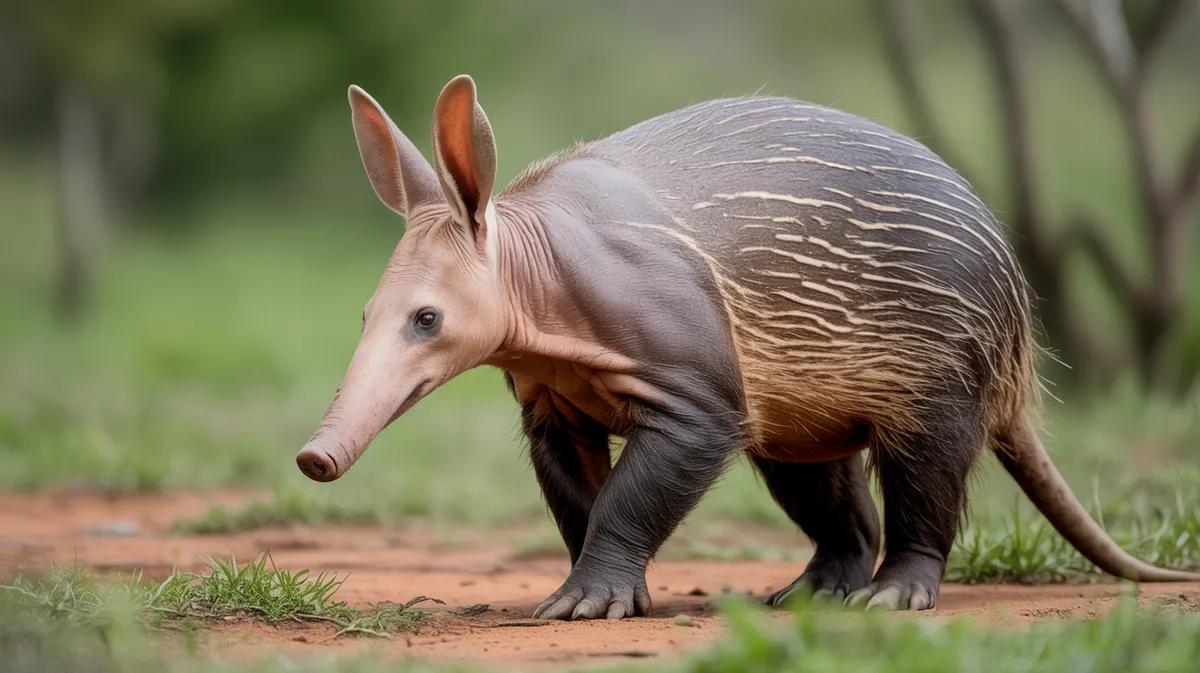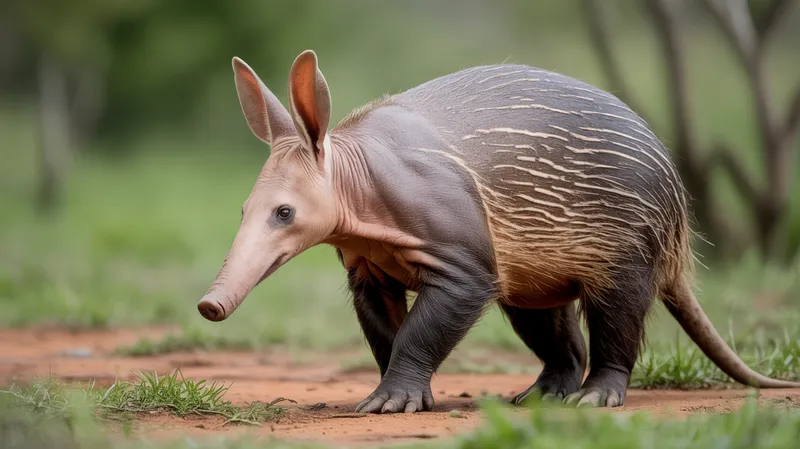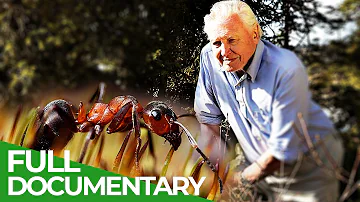
Aardvark
Orycteropus afer

Meet the Aardvark
The aardvark is a nocturnal mammal native to sub-Saharan Africa, recognized by its pig-like snout and elongated ears. It is a solitary animal that spends its nights using its powerful claws to dig for ants and termites, which make up the bulk of its diet. Despite its somewhat pig-like appearance, the aardvark is not closely related to pigs, but instead belongs to its own unique order. Its thick skin protects it from insect bites, and it can dig with incredible speed both to find food and escape predators.
Classification
Mammal
Habitat
Savanna, grassland, woodland, and open forest
Diet
Insectivore
Lifespan
10-23 years
Conservation
Least Concern
Weight
40–80 kg
📖Fascinating Facts
Unique Teeth
Aardvarks have unusual teeth made up of many thin tubes of dentine, lacking enamel, which continue to grow throughout their lives.
Nocturnal Lifestyle
Aardvarks are primarily active at night, traveling long distances in search of food using their keen sense of smell.
Expert Diggers
They are exceptional diggers, capable of creating complex burrow systems for shelter and raising their young.
📋Detailed Description
The aardvark (Orycteropus afer) is a robust, medium-sized mammal measuring 105–130 cm in head-body length, with a tail adding another 53–66 cm, and weighing between 40–80 kg. Its body is covered in sparse, coarse hair, and its skin is notably thick and tough, providing protection against insect bites and abrasive soils. The aardvark's most distinctive feature is its elongated, tubular snout, which houses a highly developed olfactory system for detecting underground insects. Its ears are long and upright, capable of swiveling independently to detect predators. The aardvark possesses strong, spade-like claws on each of its four limbs, specially adapted for rapid and efficient digging. Its dentition is unique among mammals: instead of enamel-coated teeth, it has numerous columnar, rootless teeth composed of hexagonal dentine tubules, which grow continuously throughout its life. Aardvarks are strictly nocturnal and solitary, emerging from their burrows at dusk to forage over large territories, sometimes covering 10–30 km in a single night. Their burrows, which can be up to 13 meters long, serve as crucial refuges not only for themselves but also for many other species that use abandoned aardvark burrows for shelter. The aardvark's sensory adaptations, powerful limbs, and specialized teeth make it a highly effective and ecologically significant insectivore in sub-Saharan ecosystems.
💡 Did you know?
Despite being called 'antbears' or 'earth pigs', aardvarks are the only living species in their order, Tubulidentata.
🔬Research & Sources
Wikipedia Summary
Aardvarks are medium-sized, burrowing, nocturnal mammals native to Africa. Aardvarks are the only living species of the family Orycteropodidae and the order Tubulidentata. They have a long proboscis, similar to a pig's snout, which is used to sniff out food.
Last Modified: 5/25/2025
🎭Behavior & Social Structure
Aardvarks are solitary and primarily nocturnal, spending daylight hours in deep, self-dug burrows to avoid heat and predators. They emerge at dusk and use their acute sense of smell to locate ant and termite nests, their primary food sources. Foraging is methodical: they walk with their snout close to the ground, sniffing out prey, and then use their formidable claws to break into hard termite mounds or ant nests. Once inside, they use a long, sticky tongue—up to 30 cm—to lap up thousands of insects per night. Aardvarks are generally silent but may grunt softly while foraging. They are highly secretive, rarely interacting with conspecifics outside of the breeding season. Territorial overlap is common, but direct encounters are infrequent. When threatened, aardvarks can dig rapidly to escape, or, if cornered, defend themselves with powerful claws and kicks. Their burrowing activity plays a vital ecological role, aerating soil and creating habitats for other animals.
👶Reproduction & Life Cycle
Aardvarks are polygynous, with mating typically occurring during the rainy season, varying geographically but often between May and July. After a gestation period of about seven months (approximately 233 days), a single offspring is born in the safety of a burrow. The newborn is hairless, weighing about 1.7–2.2 kg, and its eyes open within two weeks. The mother nurses the young for about three months, after which the juvenile begins to accompany her on foraging trips. By six months, the young aardvark is weaned and starts to dig its own burrow, becoming fully independent by one year of age. Sexual maturity is reached at about two years. Parental care is provided solely by the mother, and there is generally only one breeding event per year.
🛡️Adaptations & Survival
Aardvarks exhibit several remarkable adaptations for a fossorial, insectivorous lifestyle. Their strong, shovel-shaped claws and robust forelimbs enable them to excavate soil at impressive speeds—capable of digging a meter-long tunnel in under five minutes. Their nostrils can be closed to prevent dust and debris from entering while digging. The long, extensible tongue is coated in sticky saliva, allowing efficient capture of ants and termites. Their unique teeth, lacking enamel and composed of dentine tubes, are well-suited for grinding soft-bodied insects but not for chewing tough plant material. Aardvarks have a low basal metabolic rate and can tolerate high levels of carbon dioxide in their burrows, reducing the need for frequent surface activity. Their keen sense of smell compensates for poor eyesight, and their large ears provide excellent hearing, aiding in predator detection.
🎨Cultural Significance
Aardvarks hold a modest but notable place in African folklore and mythology. In some cultures, they symbolize diligence and perseverance due to their tireless digging. Their burrows are often associated with spirits or used in traditional medicine, with various body parts believed to possess protective or magical properties. The aardvark's unusual appearance has also made it a subject of curiosity in Western culture, frequently featured in children's literature and educational media as an example of evolutionary uniqueness.
🔬Recent Research & Discoveries
Recent research has focused on the aardvark's role as an ecosystem engineer, highlighting how their burrowing activity creates microhabitats for a variety of species, including reptiles, birds, and small mammals. Advances in GPS and camera-trap technology have improved understanding of their nocturnal movements and habitat use. Studies on aardvark physiology have revealed adaptations to arid environments, such as water conservation and thermoregulation. Ongoing research is investigating the impacts of climate change on aardvark distribution, particularly in relation to shifting termite and ant populations. Genetic studies have confirmed the aardvark's status as the sole surviving member of the order Tubulidentata, with no close living relatives, underscoring its evolutionary distinctiveness.
🎥Wildlife Videos

Secret Creatures: Africa's earth pig, the Aardvark.
It is several hours after sunset. Countless stars dot the wide black African sky, and in the darkness, a strange sound emanates ...
Lion Mountain TV

Pangolins and Aardvarks Search for Termites | 4K UHD | Seven Worlds One Planet | BBC Earth
The Kalahri Desert has plenty of food, but only if you can find it. Using their amazing sense of smell and digging skills, both ...
BBC Earth

Wildlife Wonders- Aardvark
As the sun sinks over the African savannah, a whole new set of animals sniff the breeze, emerging from their hiding places, ready ...
5050 Community

David Attenborough Presents: Ant Mountain | Free Documentary Nature
David Attenborough's Ant Mountain | Wildlife Documentary Watch 'David Attenborough presents: Wild City Singapore' here: ...
Free Documentary - Nature

Aardvark | the length of the tongue is 45 CM
Interesting facts from the wild world #shorts #animal #animals #animalfacts #animalshorts #animaldocumentary #nature #wildlife ...
Zoological Archive

Africa's Hunters of the Night | Wildlife Documentary
At night the hunters of Africa come out of their hiding places. The film presents the different deadly strategies that lions, leopards ...
Get.factual
🌍Habitat Information
The Aardvark typically inhabits Savanna, grassland, woodland, and open forest environments. Aardvarks have adapted to their environments with specialized features and behaviors.
Primary Habitat:
Savanna, grassland, woodland, and open forest
More detailed habitat information will be available soon.
🛡️Conservation Status
The Aardvark is currently classified as Least Concern. Conservation efforts are crucial for preserving this species for future generations.
Common Threats:
- 🏠Habitat loss and fragmentation
- 🌡️Climate change impacts
- 🎯Hunting and poaching
- 🏭Human-wildlife conflict
⚠️Threats & Conservation Challenges
While the aardvark is currently classified as Least Concern by the IUCN, it faces localized threats from habitat loss due to agricultural expansion, urbanization, and land conversion. In some regions, hunting for bushmeat or traditional medicine poses additional pressure. Aardvarks are also vulnerable to drought and changes in termite or ant populations, which can be influenced by climate change and pesticide use. Road mortality and predation by lions, leopards, hyenas, and pythons are natural threats. Although population trends are generally stable, fragmentation and declining prey availability in some areas could pose future risks, particularly as aardvarks require large, undisturbed territories.
🔬Scientific Classification
Scientific Name
Orycteropus afer
Classification Hierarchy
🔍 About Taxonomic Classification
Taxonomic classification is a hierarchical system used by scientists to classify and organize living organisms based on shared characteristics and evolutionary relationships.
The system moves from broad categories (Kingdom) to increasingly specific ones, with each animal's scientific name typically consisting of its Genus and species.
📝Community Notes
Share your observations and insights about the Aardvark with our community of wildlife enthusiasts.
Join Our Community
Sign in to share your observations and connect with fellow wildlife enthusiasts.
Sign In to ContributeNo community notes yet
Be the first to share your observations about the Aardvark!
Explore Aardvark
Select a tab above to learn more about this amazing animal.
📸Photo Gallery
No photos available for this animal yet.
🌟Discover More Wildlife
Continue your journey of discovery with more fascinating animals from our database
